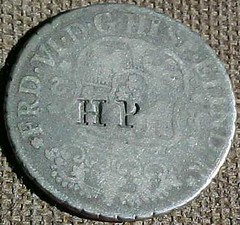
PREV ARTICLE
NEXT ARTICLE
FULL ISSUE
PREV FULL ISSUE
MYSTERIOUS LEDGER SIX NINE FOUR: TWO-CENT TALE
Two weeks Tom Kays submitted an interesting series of items based on newspaper articles found pasted in an old ledger. Here's part three, with more to follow.
-Editor
More from Mysterious Ledger Six Nine Four, a turn-of-the-twentieth century newspaper scrapbook time capsule of odd and curious tales. Here is a story evoking the original "Where's George," Mr. George that is. TWO-CENT TALE Coins Have Traveled the Country Over – Maine Soldiers Stamped Initials on Them at Port Hudson. There are two [bronze] cents, which bear the mint stamp of 1863, that have traveled over most of this country. Their journeying began when the 25th Maine Regt was encamped before Port Hudson, [Louisiana] in August 1863. One day Humphrey Pinhorn and Albert George, privates in Co. F received as part of their pay a number of new [bronze] cents which were still bright. Wishing to test the truth of several stories they heard, the two soldiers stamped their initials and the date on two cents and turned them over to the sutler in exchange for goods. The term of enlistment of the members of the regiment expired soon after the fall of Port Hudson, and the two soldiers went back to their homes in East Orrington, [Maine] where they have resided most of the time. In the summer of 1868 when Mr. George was in Portland as a member of a campaign marching club from eastern Maine, he purchased a daily paper at a newsstand, and received in change, a [bronze] cent, dated 1863 and bearing the initials "H.P." He took the coin back to his friend, who stamped the date "Aug 30, 1868," on the face and sent it going once more. In February 1869, Mr. George sold some lard to a store in Bangor and took in payment a [bronze] cent marked "A.G. 1863" which was the one he had spent in front of Port Hudson. He stamped it with the new date and passed it along. Nothing more was heard from the coins until the following June, when Mr. Pinhorn received a cent bearing the stamp of "H.P." from a friend in San Francisco who said he had read the story about the wandering coins in a Grand Army paper, and chanced to receive the identical coin soon after. He had taken the liberty to return it to its rightful owner. In October 1871, Mr. George received the "H.P." cent while making change in the post office at Bucksport, Me, and returned it to Mr. Pinhorn, who affixed another date and passed it along again. The George cent was received by a Grand Army man in Westbrook, Me, in January, 1872, who, knowing the story, mailed it back to its owner. Again it was stamped with a date and sent on its travels. It returned again in July of the same year, having been sent from Dover, Me. While Mr. George was calling at the home of Mr. Pinhorn for the purpose of showing the wandering cent, a meat cart drove up to the door, and in making change for what was purchased, the peddler gave Mr. Pinhorn, the cent that was marked "H.P." By this time the tale of the traveling cent had been published in several newspapers, resulting in having both coins returned as often as once a month. The owners wishing to avoid publicity as much as possible, both cents were enclosed in an envelope and sent to a man in Detroit, Mich., for the apparent purpose of paying postage on a seed catalog. Several months later Mr. Pinhorn received the "H.P." cent from an old soldier in St. Louis, who had read the newspaper accounts of the experiment and hoped to forward the movement. From then on until early in 1876 the Pinhorn cent was recovered five times, once by mail from Worchester, Mass, twice by friends who had taken it in business transactions, once by Mr. George, who had received it from a friend in Bangor, Me, and once by Mr. Pinhorn himself, who took it at a store in Holden, Me. – Bangor Commercial.


Surprisingly this E-Sylum contributor has an old coin with "H.P." counterstamped on its face. It was found at a civil War site at Malvern Hill. Rather than a copper-nickel cent, it is a well worn Mexican pillar two reales, dated 1760. It might as well be attributed to Humphrey Pinhorn, 25th Maine Regt., or to an unknown Grand Army of the Republic reader "in the school of Humphrey Pinhorn" who wished to set such things in motion. Does anyone know if the 25th Maine Regiment, or their sutler's train passed though Richmond, Virginia with a stop near Malvern Hill, circa 1864?
What a wonderful story! Many thanks to Tom for sharing this with us. Does anyone else have an "H.P." counterstamp? Can anyone report today's whereabouts of Humphrey Pinhorn's peripatetic cent? Or Albert George's cent?
-Editor
Wayne Homren, Editor The Numismatic Bibliomania Society is a non-profit organization promoting numismatic literature. See our web site at coinbooks.org. To submit items for publication in The E-Sylum, write to the Editor at this address: whomren@gmail.com To subscribe go to: https://my.binhost.com/lists/listinfo/esylum All Rights Reserved. NBS Home Page Contact the NBS webmaster 
|